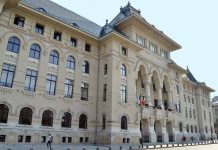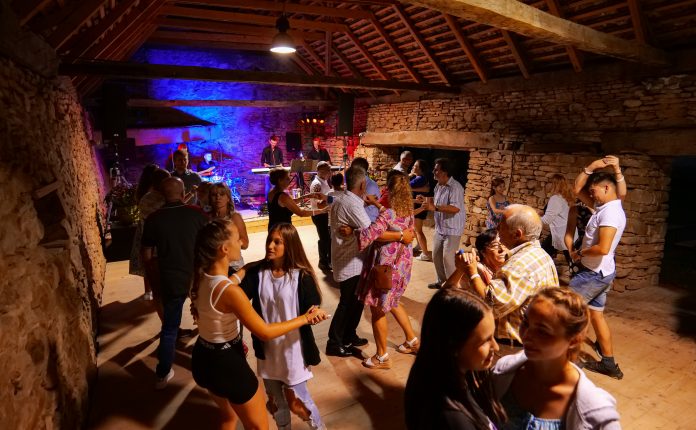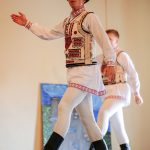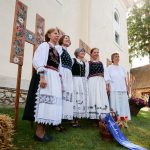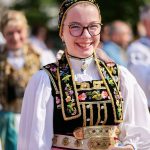- The eleventh edition of the Haferland Week, the largest festival showcasing Saxon culture and traditions in Transylvania, will take place this weekend under the patronage of His Serene Highnesses the Prince and Princess Alexander von und zu Liechtenstein.
- It’s the first time when His Serene Highnesses patronize a cultural event in Romania. The princely house that has ruled the state of Liechtenstein for over 300 years.
- The August 3-6 event will take place in ten villages located in the historical perimeter called Haferland or Oat Land, between Brasov and Sighisoara: Archita, Saschiz, Homorod, Rupea, Criț, Roades, Meșendorf, Cloașterf, Bunești and Viscri
- The theme of this year’s edition is sustainability in Haferland.
- Among the events that will take place is the reconsecration of the Evangelical Church of Rupea, one of the oldest religious monuments of the Saxon community in Romania
- Visitors will be able to enjoy concerts of Saxon music and organ, guided tours, traditional crafts workshops for children and adults, traditional Saxon balls, visits to farms and traditional courtyards of locals, tastings of organic products and much more.
„We are deeply honored by His Serene Highnesses’ decision to patronize Haferland Week, an event that has become a landmark in terms of preserving community traditions and culture,” says Michael Schmidt, President of the M&V Schmidt Foundation, festival organizer.
„The high patronage of Prince and Princess Alexander von und zu Liechtenstein is a confirmation of the importance that Haferland Week has gained in preserving the cultural specificity of the area and revitalizing the old Saxon communities inside the Carpathian arch. His Serene Highnesses are important supporters of cultural and environmental conservation initiatives, which underlines the importance of protecting such cultural areas in Europe and beyond. The Principality of Liechtenstein itself is one such example, with its specific Alemannic dialect and its unique constitutional tradition in Europe. We hope that this rapprochement will itself be the beginning of a beautiful tradition of cultural cooperation.”
Prince Alexander von und zu Liechtenstein’s family are supporters of sustainability.
Prince Alexander and his wife belong to one of the oldest princely houses in Europe, with roots going back to the twelfth century. Alexander is the son of Prince Philipp of Liechtenstein, brother of the current head of state, Sovereign Prince Hans-Adam II, and thus grandson of the latter. He has been married to Princess Astrid since 2003.
Together with their daughter, Princess Theodora, Prince Alexander and his wife have long been involved in cultural regeneration and environmental conservation projects, including in Romania, a country they have visited in the past.
Thus, Princess Theodora, together with the Green Teen Team Foundation, which she founded, supported the bison reintroduction project at Magura Bison in Armeniș (protected area of approximately 59,000 hectares, located in Caraș-Severin County). On this occasion, in 2015 the Princess visited Romania with her father. For Princess Theodora, her interest in sustainability has become a career option, and she is currently studying sustainable architecture at Cambridge University.
Equally, for Prince Alexander and his wife, heritage protection is an area of interest dating back decades. At their property in Italy, on the shores of Lake Garda, the prince and his family have restored the home, a set of buildings dating back to 1050. The family also replanted native stands among the century-old trees, revitalized the orchard and resumed artisanal olive oil production from a small olive tree plot on the property’s perimeter.
What you can see and do for four days at Haferland Week
At this year’s edition of the festival, besides the already established events – traditional Saxon balls, organ and Saxon music concerts, lectures, folk dance performances, film screenings, photo exhibitions and traditional costumes, folk costume parade, etc. – visitors will be able to witness the reconsecration of the Evangelical Church of Rupea, a recently restored architectural ensemble that includes a fortified enclosure wall, characteristic for the Saxon churches in Transylvania. The church of Rupea, founded at the beginning of the fourteenth century, was one of the major centers of spiritual life of the Saxon community in Transylvania. Few of those who have admired the organ and the wonderful carpets exhibited in the Black Church in Brasov know that they actually come from the church in Rupea. In fact, the entire ensemble of Rupea fortress, built between the XIV and XVII centuries, was restored or, where it was no longer possible, rebuilt, starting with the walls, the inner courtyard and the towers (Gate Tower, Bacon Tower, Servants’ Tower, Scout Tower, Powder Tower, etc.).
Another attraction for visitors will be tours (some guided), such as the already famous walk to Crulici’s Oak, a centuries-old tree. Those who visit the area can see live oaks of 400 or even 600 years, full of legends and local histories, almost at every step – to the northern extremity of Haferland, near Sighisoara, where the Breite plateau and its dozens of oak trees hundreds of years old are located.
Participants will also have the opportunity to visit the farms and traditional courtyards of the locals and taste organic products, and children and adults alike will be able to try their skills in live workshops of wood painting, felting, wreath-weaving, wood carving, weaving and embroidery, etc.
The entire area of Oat Country offers many opportunities for visitors, from fortified churches built since the twelfth century (Saschiz and Viscri villages being included in UNESCO World Heritage) to picturesque traditional dwellings or places that have already become famous, such as the property owned by King Charles III in Viscri, which is open to the public for visitation.
The program of the 2023 edition of the Haferland Week festival can be consulted on the event’s website, www.haferland.ro, as well as on the https://www.facebook.com/haferland and https://www.instagram.com/saptamana_haferland/ pages.
About Haferland Week
The Haferland Week Festival was initiated in 2013 by the M&V Schmidt Foundation together with the Tabaluga Foundation // Peter Maffay Stiftung, an organization founded by Romanian German musician Peter Maffay. The general objective of the event is to promote the culture and traditions of the Transylvanian Saxons, as well as to develop tourism in the Oat Country region.
This edition is funded by Brasov County Council, co-financed by the Ministry of Culture and organized in partnership with „Dimitrie Gusti” National Village Museum in Bucharest, Remarul 16 February, CON-A, Bosch Foundation Romania, Aqua Carpatica, Samburesti Domains, CEC Bank, Rompetrol, Ravago, Sefar, Caparol, Autonet, MHS Truck & Bus and Automobile Bavaria, media partners KISS Fm and Calea European.









